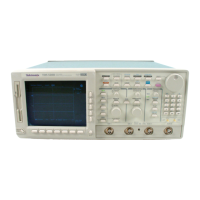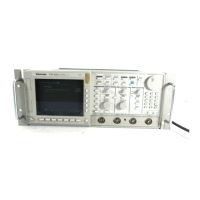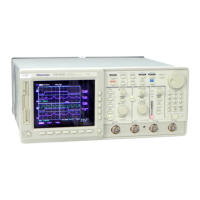Using the FFT
TDS 340A, TDS 360 & TDS 380 User Manual
3–37
example, a sample rate of 20 Megasamples/second would yield an FFT with a
range of 0 to 10 MHz. The sample rates available for acquiring data records vary
over a range the limits of which depend on your oscilloscope model. The
oscilloscope displays the sample rate in the acquisition readout at the top of the
oscilloscope screen.
To properly display your FFT waveform, scale the source waveform so it is not
clipped.
H You should scale and position the source waveform so it is contained on
screen. (Off screen waveforms may be “clipped,” which will result in errors
in the FFT waveform).
Alternately, to get maximum vertical resolution, you can display source
waveforms with amplitudes up to two divisions greater than that of the
screen. If you do, turn on Pk-Pk in the measurement menu and monitor the
source waveform for clipping.
H Use vertical position and vertical offset to position your source waveform.
As long as the source waveform is not clipped, its vertical position and
vertical offset will not affect your FFT waveform except at DC. (DC
correction is discussed below.)
Normally, the output of a standard FFT computation yields a DC value that is
twice as large as it should be with respect to the other frequencies.The displayed
output of the FFT on a TDS 300 oscilloscope is corrected for these errors to
show the true value for the DC component of the input signal. The Position and
Offset must be set to zero for the source waveform in the Vertical menu. When
measuring the amplitude at DC, remember that 1 VDC equals 1 V
RMS
and the
display is in dB.
Aliasing occurs when the oscilloscope acquires a source waveform with
frequency components outside of the frequency range for the current sample rate.
In the FFT waveform, the actual higher frequency components are under-
sampled, and therefore, they appear as lower frequency aliases that “fold back”
around the Nyquist point (see Figure 3–25).
The greatest frequency that can be input into any sampler without aliasing is
one-half the sample frequency. Since source waveforms often have a fundamen-
tal frequency that does not alias but have harmonic frequencies that do, you
should have methods for recognizing and dealing with aliases:
H Be aware that a source waveform with fast edge transition times creates
many high frequency harmonics. These harmonics typically decrease in
amplitude as their frequency increases.
H Sample the source signal at rates that are at least 2X that of the highest
frequency component having significant amplitude.
Offset, Position, and Scale
Undersampling (Aliasing)

